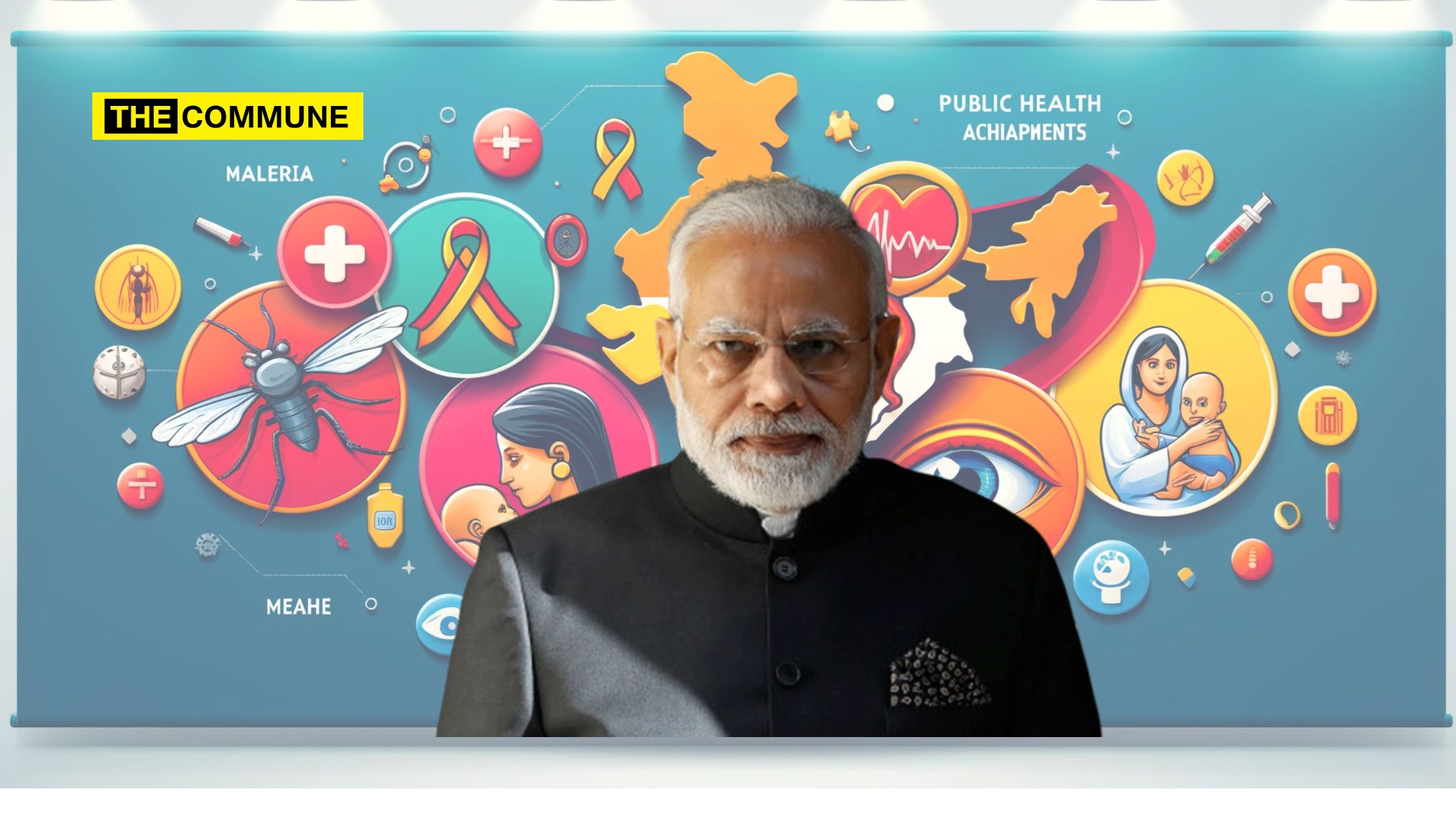
The latest WHO report highlights India, under Prime Minister Narendra Modi, made remarkable strides against diseases, including a 69% drop in malaria cases, the elimination of trachoma, and significant progress in tackling HIV, TB, and kala-azar, cementing its role as a global leader in public health.
On 11 December 2024, a WHO report disclosed that malaria cases in Bharat declined by 69% from 6.4 million in 2017 to 2 million in 2023. Similarly, malaria-related deaths were reduced by the same percentage, dropping from 11,100 to 3,500 during the same period. The report highlights 11 significant achievements – be it a reduction in various diseases across Bharat or specific states, or awards won, showcasing remarkable advancements in combating life-threatening illnesses.
69% drop In Malaria Cases Between 2017 And 2023
India has made remarkable progress in reducing its malaria burden, as highlighted in the 2024 World Malaria Report. From 2017 to 2023, malaria cases dropped by 69%, from 6.4 million to 2 million, while deaths decreased by the same percentage, from 11,100 to 3,500. This success is attributed to a multi-sectoral approach, strong political commitment, and effective interventions such as Artemisinin-based combination therapy (ACT), long-lasting insecticidal nets (LLINs), and targeted measures in high-risk areas like Jharkhand, Odisha, Chhattisgarh, and the North-East. Improved monitoring and new-generation insecticide-treated nets also played a crucial role. Globally, between 2000 and 2023, 2.2 billion malaria cases and 12.7 million deaths were averted. Additionally, more countries are adopting malaria vaccines, and WHO has certified 44 nations and one territory as malaria-free, with Egypt being the most recent addition.
44% Reduction In New HIV Infections Since 2010
India has achieved a significant 44% reduction in new annual HIV infections since 2010, surpassing the global average reduction rate of 39%. This progress underscores the nation’s commitment to ending HIV/AIDS by 2030, as reiterated by Union Minister of State for Health, Anupriya Patel, during the UN event “Revitalized Multilateralism: Recommitting to Ending AIDS Together” on September 25, 2024. Key initiatives contributing to this success include the 5th National AIDS and STD Control Programme, youth-focused awareness campaigns, and the provision of free antiretroviral therapy to over 1.7 million individuals. India also supplies 70% of the world’s antiretroviral drugs. Comprehensive testing, legal protections under the HIV and AIDS (Prevention and Control) Act, 2017, and integration with broader health programs further bolster these efforts. This achievement reflects India’s dedication to global health and its pivotal role in the fight against HIV/AIDS.
India Eliminates Trachoma Disease Completely
On 8 October 2024, India was recognized by the WHO South-East Asia Region for eliminating trachoma as a public health problem, marking a significant milestone in eye health. Trachoma, a leading cause of blindness, was responsible for 4% of blindness cases in India in 2005. By 2018, its prevalence had dropped to 0.008%. This achievement was made possible through the WHO-recommended SAFE strategy, which includes surgery, antibiotics, facial cleanliness, and environmental improvements, alongside national initiatives like the Swachh Bharat Mission and Jal Jeevan Mission.
India’s efforts, led by the Ministry of Health, involved effective surveillance, trichiasis surgeries, and widespread community awareness campaigns. WHO validated this achievement after rigorous surveys confirmed that the elimination targets had been met. India now joins 19 other countries in achieving this feat, showcasing its commitment to universal health coverage and serving as an inspiration for global efforts against neglected tropical diseases.
Missing TB Cases Drops to 2.3 Lakh in 2023
The India TB Report 2024 highlights India’s significant progress in tuberculosis (TB) control. The number of missing TB cases dropped to 2.3 lakh in 2023 from 3.2 lakh in 2022, aided by the government’s Ni-kshay portal, which tracks all TB patients. India also achieved its 2023 target of initiating treatment for 95% of diagnosed patients, with improved access to drug resistance testing (58% in 2023, up from 25% in 2015).
The private sector contributed 33% of the 25.5 lakh reported cases in 2023, a major increase from just 1.9 lakh cases in 2015. The estimated TB incidence slightly rose to 27.8 lakh in 2023, with mortality steady at 3.2 lakh. Government initiatives, including state-level workshops, social media campaigns, and local engagement, played a key role in this progress, reflecting India’s commitment to eliminating TB and improving health outcomes.
Kala-Azar Cases Dropped By 98.7% In India Since 2007
India has achieved a 98.7% reduction in kala-azar cases, dropping from 44,533 in 2007 to just 834 in 2022, according to Union Health Minister Mansukh Mandaviya. Of the 632 endemic blocks across Bihar, Uttar Pradesh, Jharkhand, and West Bengal, 99.8% have achieved elimination status (less than one case per 10,000 population), with only Littipara block in Jharkhand remaining endemic.
Kala-azar, the deadliest parasitic disease after malaria, disproportionately affects poor populations. India, contributing 11.5% of global cases, is committed to eradicating the disease by 2023. Initiatives include housing schemes under the PM-AWAS Yojana, electrification, active surveillance, free treatment, and periodic reviews. Over 90% of current cases originate from Bihar and Jharkhand, with Uttar Pradesh and West Bengal already meeting elimination targets.
47% Of Enrolled Patients Achieved Blood Pressure Control
India has made significant progress in hypertension control through the India Hypertension Control Initiative (IHCI), launched in 2017. By 2022, the program expanded to over 20,000 healthcare centres across 25 states, enrolling 40 lakh patients, with 47% achieving blood pressure control. Hypertension, affecting 20 crore adults in India, is a leading cause of heart disease, stroke, and kidney failure.
The IHCI focuses on standardized treatment, ensuring drug availability, training healthcare workers, and using technology for monitoring and patient care. Initiatives like the National Health Policy and Ayushman Bharat Yojana complement these efforts. Despite challenges like the COVID-19 pandemic, the IHCI adapted with teleconsultations and community drug distribution.
The program aims to screen and treat 75 million people by 2025 under the “75/25” initiative. Recognized globally, IHCI is improving equitable access to care, reducing uncontrolled hypertension, and strengthening primary healthcare systems.
ICMR Wins UN Award For Non-Communicable Diseases (NCD) And Mental Health Work
The Indian Council of Medical Research (ICMR) received the prestigious 2024 UN Inter-Agency Task Force Award for its efforts in advancing multi-sectoral action on preventing and controlling non-communicable diseases (NCDs), mental health, and achieving NCD-related Sustainable Development Goals (SDGs). Union Health Minister J.P. Nadda announced the recognition, highlighting ICMR’s initiatives, such as establishing national centres for assistive health technology, promoting sustainable assistive products, and conducting the world’s largest assistive technology survey.
Bengaluru Wins WHO Award For Tobacco Control And NCD Control
Bengaluru received a prestigious $150,000 grant from the World Health Organization (WHO) at the inaugural Partnership for Healthy Cities Summit in London for its outstanding tobacco control efforts, particularly reducing smoking in public places and improving compliance with smoking bans. It was one of five cities honored, alongside Athens, Mexico City, Montevideo, and Vancouver, for advancing public health initiatives to prevent non-communicable diseases (NCDs) and injuries. Supported by Bloomberg Philanthropies, WHO, and Vital Strategies, the Partnership for Healthy Cities promotes impactful interventions to tackle NCDs and injuries globally.
UP’s ‘Har Ghar Nal Se Jal’ Scheme Helped Reduce Encephalitis Deaths To Zero
Uttar Pradesh achieved a major public health milestone in 2024 by recording zero deaths from Japanese Encephalitis (JE) and Acute Encephalitis Syndrome (AES), a significant improvement from the 2005-2017 period when over 50,000 children died from these diseases. Cases of AES dropped from 1,472 in 2018 to 116 in 2024, while JE cases fell from 174 to just 5. The success is attributed to the ‘Har Ghar Nal Se Jal’ scheme under the Jal Jeevan Mission, which provided clean tap water to 85-92% of households in the worst-affected districts, including Gorakhpur, Maharajganj, and Siddharthnagar. Clean water access curbed water-borne infections and bolstered health resilience, especially in mosquito-prone areas. Chief Minister Yogi Adityanath’s focused efforts since 2017 played a pivotal role in reversing the region’s health crisis.
Rajasthan Achieves Highest Decline In Maternal Deaths
Rajasthan has achieved the highest decline in Maternal Mortality Ratio (MMR) in India, dropping from 141 deaths per 1 lakh live births in 2017-19 to 113 in 2019-20. Key factors contributing to this improvement include a rise in institutional deliveries to 95%, training for healthcare staff under the Dakshta program, and improved referrals for high-risk pregnancies. These efforts have significantly reduced preventable maternal deaths, which are often caused by complications during pregnancy and childbirth. However, the state aims to reduce MMR further to 70 or below by 2030, in line with national health targets.
Maharashtra Sees 11% Drop In Infant Mortality Since 2020
Maharashtra has achieved an 11% decline in child deaths over the past four years, from 19,185 in 2019-20 to 17,150 in 2022-23, with a 15% reduction in infant deaths. Neonatal deaths decreased by 9%, and deaths in children aged 1-5 years fell by 13%. Key factors include increased prenatal counseling, the establishment of Special Newborn Care Units, and the Mother Absolute Affection program. However, activists stress the need to focus on rural and tribal areas, where child malnutrition and infant mortality remain high. The state aims to reduce infant mortality to single digits within 3-5 years.
Subscribe to our channels on Telegram, WhatsApp, and Instagram and get the best stories of the day delivered to you personally.




